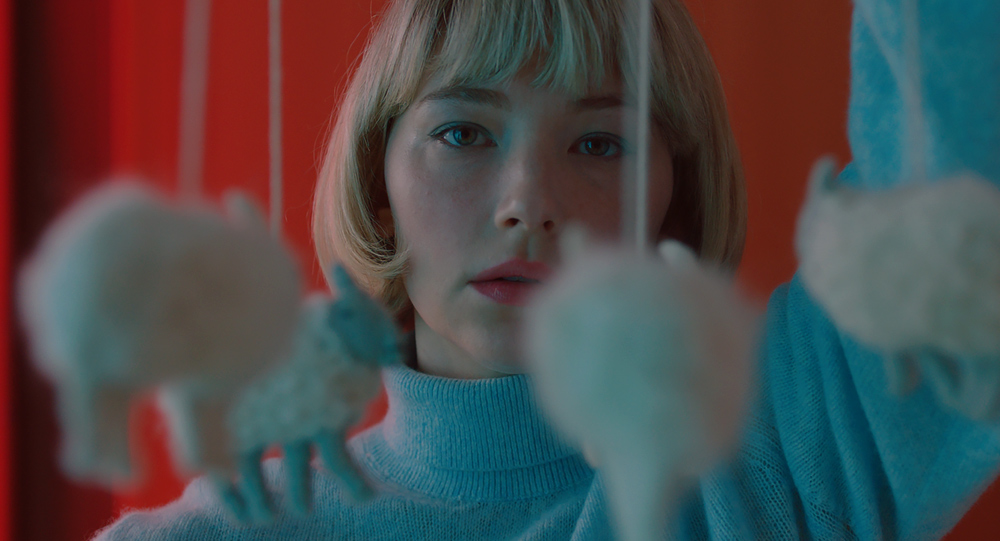As “Swallow” was nearing production, Carlo Mirabella-Davis recalls getting a call from Carole Baraton, the head of Charades, one of the French financiers of the film, with a question about the latest draft of the script. The writer/director had crafted a wicked thriller concerning a young woman (Haley Bennett) who feels trapped as a trophy wife and yearns to escape a gilded cage in the wilds of upstate New York, but the producer wondered whether he saw any opportunities for a few nervous laughs to ease the tension, asking “There is going to be a little humor in this, isn’t there?”
“I began to realize a little bit of dark humor actually helps the medicine go down,” recalls Mirabella-Davis. “Because what we’re dealing with is so intense that somehow it makes it more human because it is a psychological horror film, there’s body horror and it’s also a domestic drama with a lot of intense emotional scenes and that little lacing of dark humor makes it more relatable.”
Mirabella-Davis now could teach classes on digestion in all forms, given what he’s learned himself on “Swallow,” both a master class in cinema and an unexpectedly good time in transforming the horrifying tale of Hunter, who is compelled to ingest everyday objects to feel something in a life she always seems on the outside of looking in, into a grimly funny and unexpectedly cathartic film. Revolving around by a mesmerizing turn from Bennett, “Swallow” sees its heroine feeling alone in her marriage to Richie (Austin Stowell), whether she’s preparing the house for him during the day or having little to talk about when he comes home for dinner, and worried that she may have reached the point of no return upon learning she’s pregnant, potentially condemning her to a life of routine lived only for others.
Although passion may have been drained from Hunter’s life, Mirabella-Davis stirs it in how he vividly brings her emotions to the surface when she has trouble articulating them for herself, trafficking in bold colors that reflect a rich inner life and wide panoramic frames that express her isolation. “Swallow” creeps along in any number of ways, both masterfully paced and inducing its fair share of queasiness with Hunter’s eating disorder known as pica, until it ultimately packs a wallop, and following a celebrated run on the festival circuit after premiering at the Tribeca Film Fest last spring, Mirabella-Davis spoke about his arresting narrative debut, collaborating with a gifted crew to create such an immersive cinematic experience and how Jordan Peele blew his mind with a pair of movies long before the rest of us.
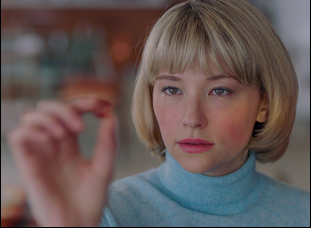
The film was inspired by my grandmother who was a homemaker in the 1950s in an unhappy marriage. She developed various rituals of control – she was an obsessive handwasher and would go through four cakes of soap a day and 12 bottles of rubbing alcohol a week, and I think she felt a need for order in the life she was powerless in. At the behest of doctors, my grandfather put her into a mental institution where she received electroshock therapy, insulin shock therapy and a nonconsensual lobotomy, so she lost her sense of taste and smell and I always felt there was something punitive about how she was treated, that she was being punished in a way for not living up to society’s expectations of what they felt a wife or mother should be.
I always wanted to make a film about that, but hand washing is not very cinematic, and I remember seeing a photograph of all the contents of someone’s stomach who had had pica that had been surgically removed. They were fanned out like an archeological dig, and I was fascinated by it and I wanted to know what drew the patient to those artifacts. They almost seemed like a mystical experience or a holy communion, so I wanted to know more. I did a lot of research into the compulsion and I also based it a little bit on my own OCD, [and after] I wrote the script, I reached out to the world’s expert on pica, Dr. Rachel Bryant-Waugh and she read a draft of the script and wrote a case study of Hunter as if she was a patient that became a very important document for us, so it was a fascinating process.
You’ve spoken before about how at one time you identified as a woman, and when this film grapples with both the way women are looked at by society and having autonomy over your body, which made me wonder whether you started on the script during that time?
I didn’t, but it was a really important time in my life where a lot of my aesthetic interests and personal beliefs were solidified, so you could argue it was written during that time in a way, but the actual writing of it happened later. For about five years in my twenties, I identified as a woman. I wore different clothing and I had a different name, and it was such a wonderful and important time in my life, and such a beautiful time of so much creativity, but it was also a real eye-opener because if you’re raised as a man, you don’t often see how baked into the cake of society sexism is. Just walking down the street and seeing the way everyone views female-identifying people and constantly trying to control them really solidified a lot of my feminist beliefs.
I’m also very interested in exploring the restriction of gender roles upon women and men as well, because I think men also have the expectations of that alpha male paradigm, and I hope the film will be a movie that a lot of people see and feel a real personal connection to. They may say, “Well, I wouldn’t swallow a dangerous object,” but they might understand Hunter’s reaction to the patriarchal structure that she finds herself embroiled in.
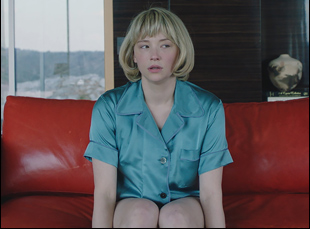
We were so incredibly fortunate that she decided to make the movie because she delivers a tour de force performance and she just poured every iota of her soul into this role. I had seen her in “Girl on the Train” and I thought she did a magnificent job and I wanted to see her in a lead role because I wanted everybody to get to see the incredible range of her talents. I felt she might be interested in doing something that was a little bit different, so I wrote her a passionate letter and she agreed to meet with me and it was an instant meeting of the minds. I’m so grateful she brought Hunter to life with so much clarity and brilliance and psychological authenticity.
Is it true you weren’t aware she had a voice in mind for the character until you heard it on set?
That’s correct. We showed up on set and Haley said, “I’m going to do a voice for the character,” and I was like “Great, let’s hear it.” and it was perfect. That innovation was so amazing because it helps chart Hunter’s psychological journey because her voice changes suddenly as the film progresses and by the end, her voice is a little bit different.
There are so many subtle shifts like that in the film – was it difficult to keep track of all the modulations?
We actually shot a lot of it in sequence, and I was really glad that my amazing producers Mollye Asher and Mynette Louie arranged it that way because it allowed us to build to this very intense climactic scene [at which] point, we all had gone through the journey that gave it the background it needed. But I am fascinated by the change that characters go through over the course of a film and I love elevating the subtext of that psychological movement in every department. For me, every single aspect of making a movie for me is storytelling, right down to the watch you’re wearing or the ambiance in a room, so with that approach, I was so fortunate to work with so many collaborators who shared that vision and poured their hearts and souls into the intricate, small details.
I was extremely lucky to be working with such an amazing design team – our incredible cinematographer Kate Arizmendi, our amazing production designer Erin Magill and our wonderful costume designer Liene Dobraja, and we all worked on how to chart Hunter’s psychological journey. For example, Kate and I came up with the idea that there would be a very strict set of camera directions rules, sort of a rigid vernacular for how we filmed Hunter, with a lot of locked down frames with her being dominated by the larger space. Then we would break those rules at very key emotional hinge moments where we’d suddenly introduce some handheld or suddenly cut in for a close-up.
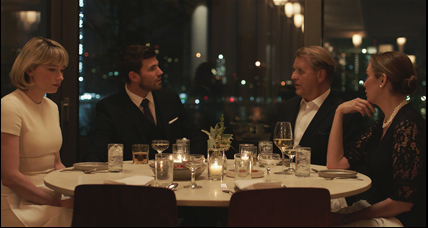
Ever since I saw “The Shining,” I began to believe that locations are a character as well and I knew I wanted a house that was very modern and all glass because when you’re in a house like that, it seems like it’s integrated into nature, but then at night especially you feel very vulnerable in that space, like you’re in a glass display case at the Museum of Natural History. You begin to feel the woods are staring at you. So I walked into that house and it’s like my God, it’s like a Hitchcock film in here, so that’s how it began. Then my incredible production designer Erin Magill passionately believed that every choice she made as a production designer reflected Hunter’s choices because Hunter is decorating the house in the film, so every object that’s there is there because Hunter chose it to be there. That’s why we see a lot of the color in the objects and the furniture that reflect the way Hunter thinks her husband wants her to be, but then there’s these little pockets and corners where her true self emerges like this red gel she puts over the window in the baby’s room or her vanity, which has more of a metallic, sharp edges.
I also loved how you attached certain sounds to certain objects. What was it like creating such a dynamic sensory experience, particularly with the items Hunter swallows?
This is a film about small things after all – small objects, small talismans and indeed every object that Hunter chooses to ingest is reminiscent of a kind of emotional memory, so with the marble we hear a little beach sound and it’s almost nostalgic, like a memory from childhood whereas the thumbtack is like a waltz in a dangerous relationship, a siren call. And I think you can hear it in the excellent sound design by Michael Kurihara, but also in Kate’s incredible cinematography, [where] you see it with the power of the reductive close-up. Kate chose to shoot the film with these master prime lenses, which are these incredibly powerful lenses that capture the texture of things because Kate felt that pica is very textural as a compulsion, so she wanted to reflect that in the way we shot it.
You’ve made documentaries and shorts before, but was a narrative feature any different?
Oh yeah, a fiction feature film is entirely its own animal. I found that making a narrative film was a really emotional and psychological journey because you start out writing it in seclusion and then there’s this miraculous moment where other people come into the process and you get to see your story reflected through their eyes. Everything that they bring to it is just thrilling and I love the duality of the narrative feature process where you’re alone writing and then you make the film with others. It’s a really incredible process.
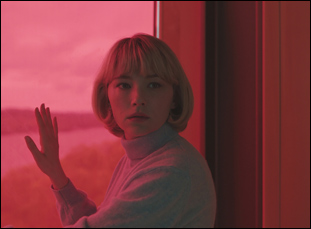
Every Sunday night, my family would order food and we’d watch an old film, so that ritual was really important to me and then my sister, Francesca Mirabella, who is also a filmmaker, and I found an old Super 8 camera at a yard sale when we were 13. We started to make strange, unusual movies with my dear friend Chris Dapkins in the woods of upstate New York with our friends and family members. That really was the genesis of my fascination with film.
Then I went to high school with Jordan Peele and when I was like 15 and he was 16, he invited me over to his house and showed me “The Shining” and “Akira” for the first time back to back. I was deeply inspired and that was the first moment where I was like, “Wow, the power of film to investigate the human mind is just unparalleled.” Of course, I followed Jordan’s career with awe – I just think he’s an amazing filmmaker and artist – and I went to film school and started watching five films a day, which I had to cut back to make some movies of my own and get some sleep. But I went to grad film at Tisch and it was wonderful.
Was it pretty special seeing your own film have that kind of power when it premiered at Tribeca? I can recall the stunned silence that followed for about a minute after the movie ended.
It’s been incredible because a lot of people are very personally and emotionally affected by the movie, so often times there will be this really touching moment after a screening where someone will come up to me after in tears and we’ll have really profound discussions about them and their life and the connections there. I’ve been all over the world with the film now, and I have to say the film has a sort of prismatic quality where people watch it and everybody finds their connection to it, so I’ve been really gratified with everybody’s responses so far and I can’t wait for everyone else to see it.
“Swallow” opens on March 6th in Los Angeles at the Arclight Hollywood and New York at the IFC Center. More cities and dates can be found here. It will also be available on VOD.




